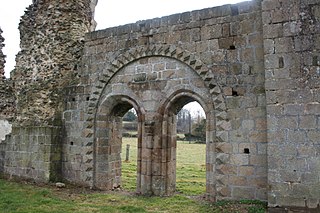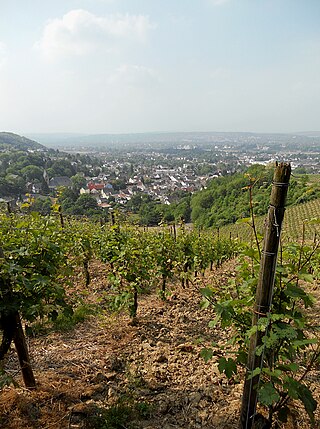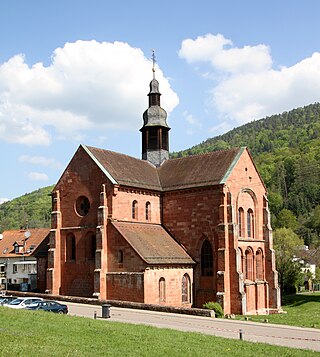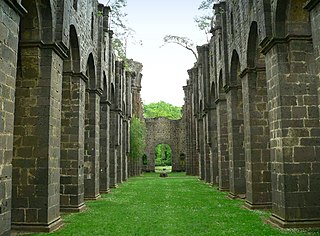
Caesarius of Heisterbach, sometimes erroneously called, in English, Caesar of Heisterbach, was the prior of a Cistercian monastery, Heisterbach Abbey, which was located in the Siebengebirge, near the small town of Oberdollendorf, Germany.

Königswinter is a town and summer resort in the Rhein-Sieg district, in North Rhine-Westphalia, Germany.

Cistercian architecture is a style of architecture associated with the churches, monasteries and abbeys of the Roman Catholic Cistercian Order. It was heavily influenced by Bernard of Clairvaux, who believed that churches should avoid superfluous ornamentation so as not to distract from prayer. Although a few images of religious subjects were allowed, such as the crucifix, elaborate figures common in medieval churches were prohibited. Later abbeys were constructed in Renaissance and Baroque styles, which were more ornate by nature.

Wilhering Abbey is a Cistercian monastery in Wilhering in Upper Austria, about 8 km (5 mi) from Linz. It was founded in 1146. The buildings, re-constructed in the 18th century, are known for their spectacular Rococo decoration.

Himmerod Abbey was a Cistercian monastery in the community of Großlittgen in the Verbandsgemeinde of Manderscheid in the district of Bernkastel-Wittlich, Rhineland-Palatinate, Germany, located in the Eifel, in the valley of the Salm.

Kamp Abbey, also known as Altenkamp Abbey or Alt(en)feld Abbey was the first Cistercian monastery founded in German territory, in the present town of Kamp-Lintfort in North Rhine-Westphalia.

The Abbey of Fontenay is a former Cistercian abbey located in the commune of Marmagne, near Montbard, in the département of Côte-d'Or in France. It was founded by Saint Bernard of Clairvaux in 1118, and built in the Romanesque style. It is one of the oldest and most complete Cistercian abbeys in Europe, and became a UNESCO World Heritage Site in 1981. Of the original complex comprising church, dormitory, cloister, chapter house, caldarium, refectory, dovecote and forge, all remain intact except the refectory and are well maintained. The Abbey of Fontenay, along with other Cistercian abbeys, forms a connecting link between Romanesque and Gothic architecture.

Savigny Abbey was a monastery near the village of Savigny-le-Vieux (Manche), in northern France. It was founded early in the 12th century. Initially it was the central house of the Congregation of Savigny, who were Benedictines; by 1150 it was Cistercian.

Herrenalb Abbey is a former Cistercian monastery in the present Bad Herrenalb in Baden-Württemberg, Germany.

Hovedøya Abbey was a medieval era Cistercian monastery on the island of Hovedøya in Oslofjord outside of Oslo, Norway.

Esrum Abbey, also Esrom Abbey, was the second Cistercian monastery founded in Denmark, located near Hillerød in Region Hovedstaden, on the island of Zealand (Sjælland), on the north side of the Esrum Sø near Esbønderup and Græsted.

Dargun Palace, previously Dargun Abbey, was a Cistercian monastery in Dargun, Mecklenburgische Seenplatte, in Mecklenburg-Vorpommern, Germany, in the former Grand Duchy of Mecklenburg-Schwerin, converted after its dissolution into a palace.

Steinfeld Abbey is a former Premonstratensian monastery, now a Salvatorian convent, with an important basilica, in Steinfeld in Kall, North Rhine-Westphalia, Germany.

Oberdollendorf is a municipal district of Königswinter, a city in the Rhein-Sieg district, in North Rhine-Westphalia, Germany. The vineyards which dominate the town are part of the Mittelrhein wine region.

Eusserthal Abbey was a Cistercian abbey in Eusserthal near Annweiler am Trifels in the Rhineland-Palatinate, Germany. All that now remains of it is the front portion of the abbey church, which is now used as a parish church.

The Petersberg, formerly known as the Stromberg, is a mountain in the Siebengebirge mountain range near Bonn, Germany. It overlooks the cities of Königswinter, on the right bank of the Rhine river, and Bonn on the opposite side. Today the peak is the site of the Hotel Petersberg, which serves as a guest house of the Federal Republic of Germany.

Arnsburg Abbey is a former Cistercian monastery near Lich in the Wetterau, Hesse, Germany. It was founded by monks from Eberbach Abbey in 1174. Although heavily damaged in the Thirty Years' War it was rebuilt later in the 17th century and prospered in the 18th century, when much of the abbey was rebuilt in Baroque style.

Marienstatt Abbey is a Cistercian monastery and a pilgrimage site in Streithausen, Westerwaldkreis, Rhineland-Palatinate, in the Nister valley near Hachenburg.




















